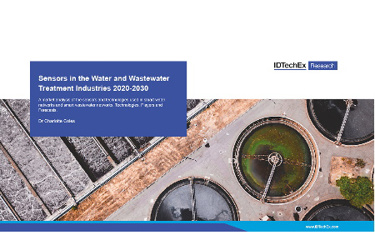Water Sensors: IoT Is The Solution, Reveals IDTechEx

IoT solutions are found in every single industry. Homeowners, for example, can use a range of internet-connected devices to help them monitor their home, to have updates on gas or electricity usage, and plan accordingly. Water companies in the UK are catching up, with many now putting smart meters into customer homes, to help them better monitor their water usage.
But could these utility companies do more? In short, yes, they could, and they should. The technology exists, it just needs to be implemented into their systems. The technology to track leaks, identify pollutants, and monitor water treatment processes is available across many applications. However, many companies are slow to adopt this new innovative technology. In their new report "Sensors in the Water and Wastewater Treatment Industries 2020-2030", IDTechEx aims to give users a deep understanding of the market, where the sensors can be used, and a holistic overview of how sensors can be implemented in water and wastewater markets.
It is possible with technology to better predict how people use water and monitor its quality. This technology currently exists. For example, manufacturing industries such as semi-conductor manufacturing monitor water for trace metals. The same sensors can be in a water network pipe. Furthermore, these methods of sensor detection have been shown to work. Companies such as Suez have implemented smart water meters to track user's water consumption in some locations in France, providing them with a better understanding of how the users consume water, and more importantly, when. IDTechEx research predicts that in the water pipe network alone, the industry of sensors will grow to over $3.5bn by 2030 (Source: "Sensors in the Water and Wastewater Treatment Industries 2020-2030"). This area is a growing industry, and it is at the forefront of the Smart Cities and IoT technology areas.
What are the benefits of sensors in pipes?
Data brings understanding and understanding brings better management of a system. Collecting data on the flow in water pipes allows companies to quickly identify regions where there is an increase in demand, and as a result, lower pressure in the pipes. Utility companies can correlate their use age data with current events. They can then answer questions such as: On average, how much water is used per day in a heatwave? Who uses the most water? What times of the day is the network strained?
Which sensors can be in water network pipes?
There are many different properties and measurements recorded in a water supply or a wastewater network, including the following:
- Pressure Measurements (static, stagnation, head)
- Flow levels (depth, pressure, velocity)
- Flow meters (velocity)
- Acoustic emission (leakage)
- Temperature measurements
- Chemical measurements (Ph, trace metals e.t.c)
IDTechEx research has covered and analyzed all these different types of measurement sensors in the report "Sensors in the Water and Wastewater Treatment Industries 2020-2030".
Who makes the sensors?
There are many players in the water and wastewater industries. The figure below shows some of those mentioned in the report "Sensors in the Water and Wastewater Treatment Industries 2020-2030".
Source: IDTechEx
